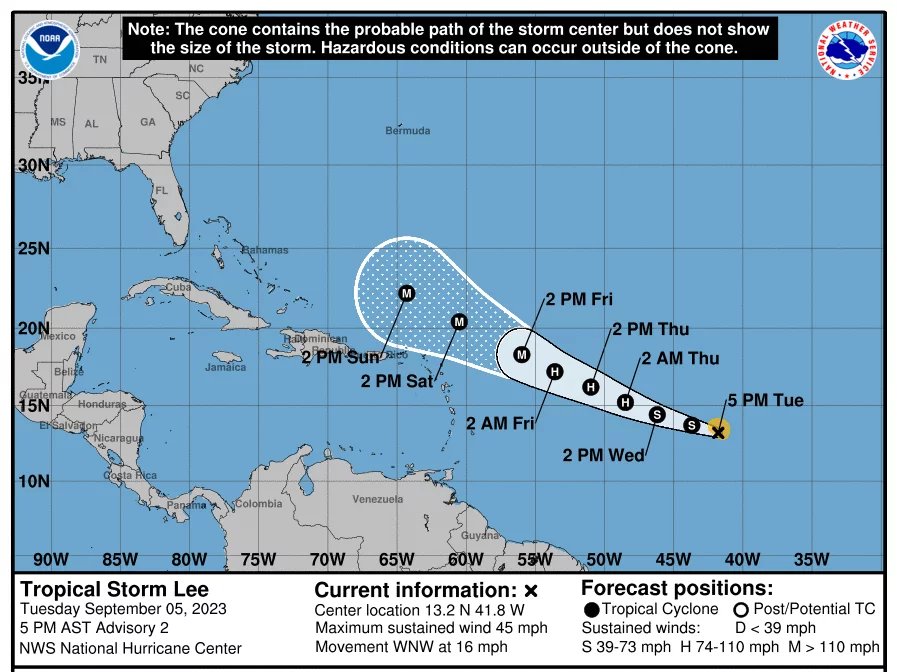Tropical Storm Lee is quickly gaining strength and is expected to become a major hurricane in the coming days. With wind speeds reaching 145 mph, it poses a significant threat to coastal areas.
Overview of Tropical Storm Lee
Tropical Storm Lee originated in the Atlantic Ocean and has been steadily moving towards land. It has already caused heavy rainfall and strong winds in some areas. As it continues to intensify, experts are closely monitoring its path and potential impact.

Impact of rapid intensification and potential wind speeds
The rapid intensification of Tropical Storm Lee is a cause for concern. As it strengthens into a major hurricane, the potential wind speeds could reach up to 145 mph. This poses a serious threat to coastal communities, as high winds can cause extensive damage to buildings, infrastructure, and vegetation.
Residents in the affected areas are advised to stay updated with the latest weather forecasts and follow any evacuation orders or safety precautions issued by local authorities. It is crucial to take necessary measures to protect life and property during this potentially dangerous weather event.
The Forecast
Weather conditions leading to the storm’s development
Tropical Storm Lee is expected to strengthen into a major hurricane in the coming days, with winds reaching up to 145 mph. The storm’s development can be attributed to a combination of favorable weather conditions. Warm ocean temperatures, low wind shear, and moist air are all contributing factors that have allowed the storm to intensify rapidly. These conditions provide the necessary fuel for the storm to grow in strength and size. As a result, it is important for residents in the affected areas to stay informed and take necessary precautions to ensure their safety.
Water temperatures and their influence on intensity
One of the key factors influencing the intensity of Tropical Storm Lee is the warm water temperatures in its path. Warm water provides the energy needed for tropical storms and hurricanes to form and strengthen. As Lee moves over these warm waters, it is expected to continue intensifying. The warmer the water, the more energy is available for the storm to tap into, potentially leading to further strengthening. This highlights the importance of monitoring water temperatures as they can provide valuable insights into the potential intensity of a storm.
Historical Comparison
Examination of previous years with high Atlantic named storms by September 5th
Tropical Storm Lee is rapidly intensifying and is projected to become a major hurricane with winds reaching up to 145 mph. As we brace ourselves for this powerful storm, it’s essential to understand the historical context and compare it to previous years.
By September 5th, some years have experienced a significant number of named storms in the Atlantic. For example, in 2005, there were already 12 named storms by this date, including Hurricane Katrina. In contrast, other years have seen fewer storms, such as 2014, with only four named storms by September 5th.
Comparison of storm activity and potential implications
The intensity and frequency of tropical storms can vary from year to year. While Tropical Storm Lee is expected to become a major hurricane, it’s crucial to note that each storm has its unique characteristics and potential implications. It’s essential to stay informed and follow the guidance of local authorities to ensure the safety of yourself and your loved ones.
Remember to take necessary precautions, such as securing loose objects and stocking up on essential supplies. Stay tuned to reliable weather sources for updates on Tropical Storm Lee’s progress and heed any evacuation orders if necessary.
Anticipated Path and Timing
Forecasted trajectory of Tropical Storm Lee
Tropical Storm Lee is expected to intensify into a major hurricane with winds reaching up to 145 mph. The storm is currently located in the Atlantic Ocean and is projected to follow a northwestern path. While the exact trajectory may vary, forecasters predict that Lee will continue to strengthen as it moves towards the eastern coast.
Timing of potential landfall and areas at risk
The timing of Tropical Storm Lee’s potential landfall is still uncertain, but it is anticipated to make landfall within the next few days. Areas along the eastern coast, particularly from Florida to North Carolina, are at risk of being affected by the storm. Residents in these areas should closely monitor updates from local authorities and take necessary precautions to ensure their safety.
As always, it is important to stay informed about the latest developments and heed any evacuation orders or warnings issued by officials.
Potential Impact
Discussion of the expected wind speeds and their implications
Tropical Storm Lee is rapidly intensifying and is expected to become a major hurricane with wind speeds reaching up to 145 mph. These strong winds can have significant implications for the affected areas.
Firstly, the high wind speeds can cause extensive damage to buildings, infrastructure, and vegetation. Trees may be uprooted, power lines could be knocked down, and roofs may be torn off. It is important for residents in the path of the storm to secure loose objects and take necessary precautions to protect their property.
Secondly, the strong winds can also lead to dangerous storm surges along coastal regions. This can result in flooding, erosion, and damage to coastal communities. Residents in low-lying areas should be prepared for potential evacuation orders and follow instructions from local authorities.
Potential damage to coastal regions and communities
Coastal regions are particularly vulnerable to the impact of Tropical Storm Lee. The combination of high winds and storm surges can lead to significant damage and disruption. Coastal communities may experience flooding, beach erosion, and damage to infrastructure such as roads, bridges, and buildings.
It is crucial for residents in these areas to closely monitor updates from local authorities and follow evacuation orders if necessary. Taking proactive measures such as securing property, stocking up on essential supplies, and having an emergency plan in place can help mitigate potential damage and ensure the safety of individuals and communities.
Overall, Tropical Storm Lee’s potential transformation into a major hurricane with 145 mph winds poses a significant threat to coastal regions. It is important for residents to stay informed, take necessary precautions, and prioritize their safety during this time.



